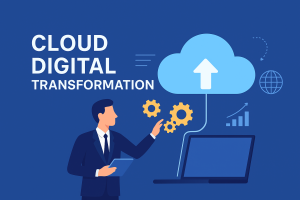Software development doesn’t end once a product is launched—it’s only the beginning of a long-term relationship between technology and business growth. Many organizations pour time and resources into creating innovative software, yet fail to realize that post-deployment activities like software support and maintenance are just as crucial for achieving sustained success. Going beyond bug fixes means ensuring your software continues to deliver value, stay secure, and evolve with your business and customer needs.
In this blog, we’ll explore how software support and maintenance directly contribute to business success, covering key areas like performance optimization, customer satisfaction, cost efficiency, and long-term competitiveness.
Understanding Software Support and Maintenance
Before diving into the benefits, let’s clarify what these terms mean.
Software Support refers to the technical assistance provided after deployment to help users troubleshoot issues, improve usability, and ensure smooth operation. It includes tasks like resolving user complaints, monitoring system behavior, and updating documentation.
Software Maintenance, on the other hand, focuses on improving and upgrading the software itself. It involves fixing defects, optimizing performance, enhancing features, and adapting the system to new technologies or business requirements.
Together, support and maintenance form the backbone of software lifecycle management, ensuring that your product remains reliable, relevant, and competitive long after its initial release.
1. Sustaining Business Continuity
Every minute of downtime can translate into lost revenue and diminished customer trust. Software maintenance ensures your applications are stable and operational 24/7, preventing unexpected disruptions that could stall operations.
Routine performance monitoring, proactive debugging, and regular updates minimize risks associated with outdated libraries or security vulnerabilities. This continuity is particularly vital for businesses relying on SaaS platforms, e-commerce systems, and enterprise applications that power daily operations.
Example:Imagine an online retail company whose payment gateway crashes during peak shopping hours. With proactive software support in place, issues like server overloads or API timeouts can be detected and resolved before they impact customers.
2. Enhancing Customer Experience
User satisfaction is a direct reflection of how smoothly your software runs. Support and maintenance help create a seamless user experience by addressing issues promptly and incorporating user feedback into future updates.
Regular maintenance ensures faster load times, smoother navigation, and compatibility with the latest devices or browsers—all of which improve user retention.
Fact: According to a study by PwC, 73% of consumers say a good experience is a key factor influencing their brand loyalty. If your software lags or crashes often, customers won’t hesitate to switch to a competitor.
By investing in ongoing support, businesses demonstrate commitment to their users, building trust and long-term loyalty—an essential ingredient in business success.
3. Security and Compliance
Cybersecurity threats are evolving faster than ever. Without regular software maintenance, your system can quickly become vulnerable to breaches, data leaks, or compliance failures.
Maintenance teams continuously patch vulnerabilities, update encryption protocols, and ensure compliance with industry standards like GDPR, HIPAA, or ISO. Support teams also play a role in monitoring suspicious activities and responding to incidents swiftly.
This proactive approach not only safeguards sensitive data but also strengthens brand reputation. Businesses that prioritize secure and well-maintained software are more likely to attract and retain clients in data-sensitive industries like finance, healthcare, and e-commerce.
4. Reducing Long-Term Costs
At first glance, continuous software support and maintenance may appear as additional expenses. However, neglecting them can lead to much higher costs in the long run.
Fixing small issues early prevents them from snowballing into major system failures. Similarly, regular updates keep your software compatible with new hardware and operating systems, avoiding expensive reengineering later.
Cost Example: Consider an enterprise that delays maintaining its CRM system. When compatibility issues finally arise with new cloud infrastructure, they face significant downtime and emergency development costs—expenses that could have been avoided through routine maintenance.
Thus, proactive maintenance is not just a technical necessity—it’s a strategic financial investment that enhances profitability and stability.
5. Keeping Up with Technological Advancements
Technology evolves rapidly. Without continuous improvement, your software risks becoming outdated or irrelevant. Maintenance ensures that your product adapts to emerging technologies, frameworks, and user expectations.
Regular updates might include integrating AI-powered analytics, optimizing for mobile responsiveness, or transitioning to cloud-based infrastructure. These adaptations help businesses stay ahead of the competition and align their software with modern digital trends.
Furthermore, businesses can leverage user feedback and performance analytics from the support team to introduce new features that enhance market differentiation.
6. Improving Productivity and Internal Efficiency**
Software maintenance doesn’t just benefit customers—it also streamlines internal workflows. By ensuring smooth integrations, updated tools, and stable systems, employees can focus more on their core responsibilities rather than dealing with constant technical glitches.
Automation tools, system performance upgrades, and improved user interfaces—all outcomes of regular maintenance—boost employee efficiency. This internal productivity translates into faster project delivery and improved organizational performance.
7. Building Long-Term Customer Relationships
Quality post-deployment support is one of the strongest indicators of a brand’s reliability. Clients and users appreciate when their concerns are addressed promptly and effectively.
Through ongoing communication channels, dedicated support teams can gather feedback, provide real-time assistance, and foster stronger customer relationships. Over time, this relationship transforms customers into advocates who promote the product organically.
Businesses that prioritize software support gain a competitive edge by turning service interactions into opportunities for trust-building and retention.
8. Enabling Data-Driven Decision Making
Maintenance and support activities often generate valuable data about user behavior, performance trends, and potential improvement areas. By analyzing this data, businesses can make smarter decisions about product enhancements, marketing strategies, and resource allocation.
For instance, recurring support tickets about a specific feature can highlight usability issues, guiding design improvements. Similarly, performance logs can uncover bottlenecks that, once resolved, significantly improve system speed.
Data-driven insights from maintenance and support not only enhance software quality but also inform strategic business planning.
9. Supporting Scalability and Growth
As your business expands, your software must be capable of handling increased users, data, and functionality demands. Maintenance ensures scalability by optimizing system architecture and updating infrastructure to meet growing needs.
Without consistent maintenance, scaling up becomes complex, often requiring a complete rebuild instead of incremental upgrades. With proactive support, performance monitoring, and code optimization, your software grows in tandem with your business.
This adaptability ensures your digital ecosystem remains strong and flexible, enabling innovation rather than hindering it.
10. Strengthening Brand Reputation
A company’s digital performance directly influences its brand image. Frequent errors, outdated designs, or poor user experiences can erode credibility quickly.
Software support ensures rapid resolution of issues, while maintenance keeps the product visually and functionally aligned with modern standards. This combination demonstrates professionalism and reliability—traits that customers and partners highly value.
Brands recognized for dependable software maintenance are often viewed as trustworthy technology leaders in their industries.
Conclusion: Software Maintenance as a Growth Engine
Software support and maintenance go far beyond fixing bugs—they represent a strategic commitment to excellence, innovation, and customer satisfaction. From improving security and reducing costs to enabling scalability and sustaining brand reputation, these services form the foundation for long-term business success.
When done right, support and maintenance transform software from a static product into a dynamic, evolving asset that grows alongside your business goals.
Forward-thinking companies understand that success doesn’t end at launch—it begins there. Organizations that invest in ongoing software improvement are the ones best equipped to thrive in a fast-changing digital landscape. At Redtgs, the philosophy is simple: empower businesses through reliable, future-ready technology that performs flawlessly every day. By prioritizing proactive software support and intelligent maintenance, companies can truly go beyond the bug fixes—turning technical stability into lasting competitive advantage.
Frequently Asked Questions
1. What is the difference between software support and software maintenance?
Software support focuses on assisting users after deployment by resolving technical issues and ensuring smooth operation. Software maintenance, on the other hand, involves updating, optimizing, and enhancing the software to keep it efficient, secure, and aligned with business goals.
2. Why is software maintenance important for business continuity?
Software maintenance prevents downtime by keeping systems stable, secure, and up-to-date. Regular updates and proactive monitoring help identify potential problems before they disrupt business operations, ensuring consistent performance and reliability.
3. How does proactive support improve customer satisfaction?
Proactive support ensures issues are resolved before users even notice them. When software runs smoothly, loads faster, and stays compatible with new devices, it enhances the overall user experience—leading to improved satisfaction and loyalty.
4. What role does maintenance play in software security?
Maintenance teams apply regular security patches, update encryption methods, and close potential vulnerabilities. This proactive approach protects sensitive data, reduces cyber threats, and helps businesses stay compliant with regulations like GDPR or HIPAA.
5. How can software support and maintenance reduce long-term costs?
Addressing small bugs early prevents expensive system failures later. Routine maintenance also avoids compatibility issues with new hardware or operating systems, saving businesses from costly rebuilds or downtime.
6. How do support and maintenance help businesses stay competitive?
Through regular updates, businesses can integrate new technologies, improve performance, and introduce innovative features. This adaptability keeps the software relevant and aligned with modern market demands, giving businesses a competitive edge.
7. Can maintenance improve internal team productivity?
Yes. Well-maintained systems reduce technical disruptions, allowing employees to work efficiently. Improved performance, automation, and reliable integrations help teams focus on strategic business activities instead of technical troubleshooting.
8. How do support and maintenance contribute to better decision-making?
Data gathered from support tickets and performance monitoring reveals usage patterns and common issues. These insights help businesses prioritize enhancements and make informed decisions about software development and resource allocation.
9. What happens if a business neglects software maintenance?
Neglecting maintenance can lead to security breaches, compatibility problems, performance degradation, and higher repair costs. Over time, the software may become outdated, resulting in customer dissatisfaction and reduced competitiveness.10. How do software support and maintenance strengthen brand reputation?
Consistent performance, quick issue resolution, and regular updates showcase professionalism and reliability. Businesses that invest in ongoing maintenance are perceived as trustworthy and customer-focused, enhancing their brand image.






